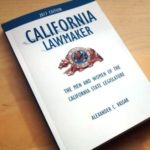In the late 1950s, as the Cold War began to escalate, the California Legislature began to work on finding a way to allow the civil government to continue after the impending nuclear war.
| To read the reports by the California Assembly’s Subcommittee on Impact of Enemy Attack, visit our Legislative Committees Reports section. |
From 1956 to 1959, the Assembly’s Subcommittee on Impact of Enemy Attack on Economy and Constitutional Government of the State of California discussed a number of steps that could be taken to preserve a civilian government (and avoid martial law) after the attack.
Although the attacks never came, many of the laws written by the committee remain in effect today, waiting to be dusted off for the day after the end o f the world;
Situation II
The scenario deemed most likely (and therefore most important to prepare for) by the Committee was named Situation II. Situation II was a four-pronged attack on California targeting Los Angeles, San Francisco, Sacramento, and San Diego. With only fifteen minutes warning, the attack was expected to leave 5 million Californians dead and 4 million homeless (California’s population was only 14 million at the time). The strike on Sacramento would likely destroy all government records stored there and leave most of the legislators and constitutional officers dead.
The Atomic Vault at Felton
A preemptive action taken by Secretary of State Frank M. Jordan was to protect what he thought were California’s most vital records. The documents; the original laws of the State of California, original journals of the Legislature, the State Constitution and Spanish Archives were microfilmed and stored in an atomic bunker near Felton (in the Santa Cruz Mountains). This bunker, was created as “Zayante Tunnel” by the Southern Pacific Railroad to carry train tracks through the mountains. The tunnel was purchased by the Western States Atomic Vault Company in 1954. It is now owned by a company named Filesafe and is used to store corporate records.
An Alternate Seat of Government
As of 1959,”the campus of Chico State College in Chico, Butte County, is designated as the alternate seat of State Government and the emergency control center for disaster relief.” The Committee looked into alternate sites before settling on a promising option; an abandoned limestone quarry near Sonora, owned by the United States Lime Products Co., could be prepared for an emergency for as little as $25,000. Rather than spend the money to convert the mine into a command center, the legislature passed AB 69 (1958) which requires that “the Governor shall designate by written proclamation an alternative temporary seat of government”. This law remains in effect today as Government Code section 450.
The Disaster Acting Governors
Prior to the committee, the line of succession for California’s Governor included just the Lieutenant Governor and Senate President pro Tem. The chairman of the committee, Assemblyman Vernon Kilpatrick, authored ACA 1X5 (1958) to allow the legislature to add other offices to the line of succession, including the statewide offices of Assembly Speaker, Secretary of State, Attorney General, Treasurer, and Controller (SB 1530 of 2008, by Senator Dennis Hollingsworth, added the Superintendent of Public Instruction, Insurance Commissioner, and Chair of the Board of Equalization to the list.) This law remains in effect today as Government Code sections 12058-59.
Additionally, the committee also authored AB 1714 (1959), which permits the Governor to appoint up to seven “Disaster Acting Governors” to take assume the office of Governor in the event that the Governor (and the rest of the line of succession) is “killed, missing or so seriously injured as to be unable to perform his duties.” This law remains in effect today as Government Code section 12050-53.
Legislators Pro Tem
In order to provide an adequate filing period for candidates and for officials to conduct an election, California law states that special elections must be timed between “112 and 126 days after the Governor calls the election.” In order to restore a functioning civil government in the aftermath of a nuclear war, the committee wrote a law which allows for the emergency restocking of the legislature in the event that an enemy attack kills more than one-fifth of either house (8 Senators or 16 Assemblymembers).
AB 1×68 (1958) permits the Governor (or acting Governor) to appoint “legislators pro tem” to temporarily fill vacancies until a special election can take place. This law remains in effect today as Government Code section 9004.

Leave a Reply
You must be logged in to post a comment.